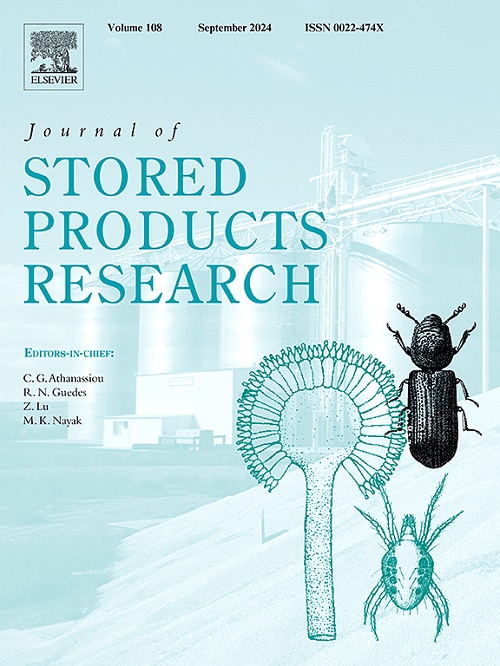Peanut seed molds affected by chitosan loaded with different antimicrobial agents
IF 2.7
2区 农林科学
Q1 ENTOMOLOGY
引用次数: 0
Abstract
To prevent peanuts from being contaminated by fungal or bacterial toxins, particularly aflatoxin B1 (AFB1), during storage—factors that could adversely affect their quality and taste—this study investigated the effects of chitosan combined with various antimicrobial agents on peanut seed molds. Distilled water served as the control, while chitosan acted as the coating agent. By comparing the effects of different antimicrobial agents (natamycin, gallic acid, cinnamaldehyde, tea polyphenols, and lavender essential oil), we explored the feasibility of using chitosan as a carrier and its potential applications. Among the treatments, the chitosan-lavender essential oil group demonstrated exceptional performance in reducing insect pests, decreasing from 5.4 % in the control group to 1.82 % after 12 months of storage. The chitosan-natamycin group exhibited the best results across all other metrics, reducing AFB1 content from 60.33 μg/kg to 4.95 μg/kg compared to the control group. Additionally, seed germination improved from 52.33 % to 80.33 %, and the insect pest rate was comparable to that of the chitosan-lavender essential oil group at 1.83 %. Water content increased from 10.19 % to 15.17 %, and protein content rose from 15.70 % to 23.52 % after 12 months of storage. Chitosan-loaded antimicrobials effectively inhibited mold growth to varying degrees, with the chitosan-natamycin combination proving to be the most effective.
壳聚糖负载不同抗菌剂对花生种子霉菌的影响
为了防止花生在贮藏过程中受到真菌或细菌毒素的污染,特别是黄曲霉毒素B1 (AFB1)的污染,本研究研究了壳聚糖与各种抗菌剂联合使用对花生种子霉菌的影响。以蒸馏水为对照,壳聚糖为包衣剂。通过比较纳他霉素、没食子酸、肉桂醛、茶多酚和薰衣草精油等不同抑菌剂的抑菌效果,探讨壳聚糖作为载体的可行性及其应用前景。其中壳聚糖-薰衣草精油组的除虫效果较好,保存12个月后,除虫率由对照组的5.4%降至1.82%。壳聚糖纳他霉素组在所有其他指标上表现最好,与对照组相比,AFB1含量从60.33 μg/kg降至4.95 μg/kg。种子发芽率由52.33%提高到80.33%,害虫率与壳聚糖薰衣草精油组的1.83%相当。贮藏12个月后,水分含量由10.19%提高到15.17%,蛋白质含量由15.70%提高到23.52%。负载壳聚糖的抗菌剂在不同程度上有效抑制霉菌生长,其中壳聚糖-纳他霉素组合被证明是最有效的。
本文章由计算机程序翻译,如有差异,请以英文原文为准。
求助全文
约1分钟内获得全文
求助全文
来源期刊
CiteScore
5.70
自引率
18.50%
发文量
112
审稿时长
45 days
期刊介绍:
The Journal of Stored Products Research provides an international medium for the publication of both reviews and original results from laboratory and field studies on the preservation and safety of stored products, notably food stocks, covering storage-related problems from the producer through the supply chain to the consumer. Stored products are characterised by having relatively low moisture content and include raw and semi-processed foods, animal feedstuffs, and a range of other durable items, including materials such as clothing or museum artefacts.

 求助内容:
求助内容: 应助结果提醒方式:
应助结果提醒方式:


